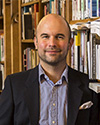Davide Ballabio, Ph.D.
Università degli Studi di Milano-Bicocca, Italy

Davide Ballabio earned a degree in environmental sciences in 2002 and earned his Ph.D. in 2007. Since then, he has been working in chemometrics to model both analytical data and the quantitative structure activity relationship (QSAR), especially applying classification and supervised pattern-recognition approaches. He is an associate professor at the Università degli Studi di Milano-Bicocca (University of Milano-Bicocca) in Italy. He has authored more than 90 papers in international peer-reviewed scientific journals and has authored several MATLAB toolboxes for the calculation of multivariate models.
Arianna Bassan, Ph.D.
Innovatune

Arianna Bassan is a chemist with expertise in computational toxicology, cheminformatics, and databasing. She is currently part of the Innovatune team, a science- and technology-based company providing consulting services based on the use of in silico toxicology, with a focus on pharmaceuticals. She applies in silico approaches, such as read-across, QSAR, alerts, and categories, for the evaluation of human health endpoints for data-poor substances. She is currently part of an international scientific community of experts aiming at standardizing industrial and regulatory applications of computational toxicology, specifically in silico toxicology protocols. She graduated from the University of Padova, Italy, and earned her Ph.D. in chemical physics at Stockholm University in Sweden. She worked several years in international environments, including Stockholm University, MSD/Merck & Co., and the Joint Research Centre of the European Commission. In addition to her activities related to the use of in silico methods for human health hazard assessment, she has led different scientific projects, focusing on data curation and data management, such as the development of the European Food Safety Authority’s hazard database OpenFoodTox and management of pre-clinical data for pharmaceutical companies.
Andreas Bender, Ph.D.
University of Cambridge

Andreas Bender is a professor for molecular informatics at the University of Cambridge. Previously, he was a director for digital life sciences at Nuvisan in Berlin, as well as an associate director for data science and artificial intelligence in the Clinical Pharmacology and Safety Sciences group at AstraZeneca. In his work, Andreas is involved with the integration and analysis of chemical and biological data from different sources, such as structural and bioactivity data, gene expression readouts, cellular imaging data, pathway information, and more. He then uses these computational analyses to understand phenotypic compound action – such as cellular readouts and organism-level effects – on a mechanistic level, predicting molecular properties related to both compound efficacy and toxicity, as well as compound repurposing. Bender received his Ph.D. from the University of Cambridge and worked in the Lead Discovery Informatics group at Novartis in Cambridge, Massachusetts, as well as at Leiden University in the Netherlands, before his current posts.
Charles Bevington, M.P.H.
U.S. Consumer Product Safety Commission
Charles Bevington is a health scientist in the Health Sciences Directorate at the U.S. Consumer Product Safety Commission (CPSC). He primarily focuses on exposure assessments of chemical substances used in consumer products. Additionally, he contributes to reviews of chemical hazards in support of chemical risk assessment from a wide range of consumer products. In this capacity, he supports development of regulatory and voluntary standards. Prior to joining CPSC, Bevington supported EPA’s Office of Pollution Prevention and Toxics as an exposure scientist, both before and after the 2016 Lautenberg amendments to the Toxic Substances Control Act. Bevington received an M.P.H. in environmental and occupational health from the University of Nebraska Medical Center.
William Bisson, Ph.D.
Inotiv

William Bisson is a senior scientist at Inotiv, a contracting firm supporting the Report on Carcinogens in the NIEHS Division of the National Toxicology Program. He completed his doctorate in medicinal and computational chemistry from the Swiss Federal Institute of Technology (ETH) in Zurich, Switzerland, in 2003. He is a recognized expert in computational chemical genomics. His interdisciplinary research interests focus on understanding the chemical biology of small molecules in environmental carcinogenesis for precision prevention and environmental health.
Elena Fioravanzo, Ph.D.
ToxNavigation

Elena Fioravanzo has over 30 years’ experience in computational chemistry. She is the driving force behind ToxNavigation, a consultancy utilizing the latest methods of computational toxicology to facilitate the chemical risk assessment process. She is also ToxNavigation's primary online trainer, teaching professional development courses for toxicologists and chemists. Fioravanzo earned her degrees at the University of Milan.
Denis Fourches, Ph.D.
Oerth Bio

Denis Fourches is the senior director of data science and modeling at Oerth Bio, an agricultural technology company pioneering the development of protein degraders for various applications in agriculture. Prior to joining Oerth in 2020, Fourches was an assistant professor at North Carolina State University in the Department of Chemistry and the Bioinformatics Research Center.
Andrea Gissi, Ph.D.
European Chemicals Agency

Andrea Gissi joined the computational assessment unit of the European Chemicals Agency (ECHA) in 2013. His main activities include project management of the international Organisation for Economic Co-operation and Development (OECD) QSAR Toolbox software; the assessment of the validity of QSAR results in Registration, Evaluation and Authorization of Chemical Substances (REACH) regulations; and participation in QSAR-related activities at the OECD level. Andrea holds a Ph.D. and master’s degree in medicinal chemistry.
Huixia Hong, Ph.D.
U.S. Federal Drug Administration, National Center for Toxicological Research

Huixiao Hong is a senior biological research and biological product assessment service expert, and the chief of the bioinformatics branch at the National Center for Toxicological Research at the U.S. Food and Drug Administration. Previously, he was the manager of the bioinformatics division at Z-Tech, a research scientist at Sumitomo Chemical Company in Japan, a visiting scientist at the National Institutes of Health (NIH), and an associate professor and director of Computational Chemistry Laboratory at Nanjing University in China. Hong is a member of OpenTox association steering committee and the leadership circle of the FDA modeling and simulation working group. He received his Ph.D. from Nanjing University in China, then conducted research at Leeds University in England. He has more than 240 publications.
Esther Kellenberger, Ph.D.
Université de Strasbourg, France

Esther Kellenberger obtained a Ph.D. in Biophysics from Strasbourg University in 2000. She was a Von Humboldt fellow at the European Molecular Biology Laboratory in Heidelberg, Germany, in 2001. She has since worked in the Faculty of Pharmacy, Strasbourg. She was appointed Professor in Bioinformatics in 2015. She was president of the French Society of Cheminformatics (2016-18) and the working group leader of the European COST Action GLISTEN (2013-17). She has been vice-dean of the Faculty of Pharmacy since 2018, and an elected member of the central council of the University of Strasbourg since 2021.
Cathy Lester, Ph.D.
The Procter & Gamble Company

Cathy Lester holds a Ph.D. in physical chemistry from the University of Rochester and has been with The Procter & Gamble Company for 24 years. She has worked in human safety for the past 11 years, focusing on research in read-across, a new approach methodology for risk assessment.
Thomas Luechtefeld, Ph.D.
Insilica.co

Thomas Luechtefeld is the founder of Insilica.co, where he builds chemical informatics models and document-review applications. He leads technical development on the informatics tools Biobricks.ai, a data registry for cheminformatic and life science data, and Sysrev.com, a document review platform. He has been building chemical similarity methods since starting his Ph.D. in 2016 at the Johns Hopkins University and helps apply them in products like the Underwriters Laboratories Cheminformatics Toolkit.
Gilles Marcou, Ph.D.
Université de Strasbourg, France

Gilles Marcou, is an Associate Professor at the University of Strasbourg and experienced lecturer with a demonstrated history of working with the chemicals industry. Skilled in Cheminformatics, Bioinformatics, Virtual Screening and Computer Programming, his research now specializes in the field of Cheminformatics. He is the head of the master Erasmus Mundus Chemoinformatics+: Artificial Intelligence in Chemistry and international network of master double degrees in Chemoinformatics. Since 2020, he has been an active expert for ANSES (Agence nationale de sécurité sanitaire de l'alimentation, de l'environnement et du travail).
Todd Martin, Ph.D.
U.S. Environmental Protection Agency

Todd Martin has over fifteen years of experience in computational toxicology. He is the lead developer of TEST (Toxicity Estimation Software Tool), which allows users to easily estimate several toxicity- and physical-property endpoints from molecular structure. He has authored over 20 papers in the areas of computational toxicology, pollution prevention, and alternatives assessment.
José Medina-Franco, Ph.D., F.R.S.C.
Universidad Nacional Autónoma de México

José Medina-Franco holds a bachelor’s in chemistry, a Master’s of Science, and a Ph.D, all from the Universidad Nacional Autónoma de México (UNAM or National Autonomous University of Mexico). Medina-Franco joined the University of Arizona in 2005 as a postdoctoral fellow and was named an assistant member at the Torrey Pines Institute for Molecular Studies in Florida in 2007. In 2013, he conducted research at the Mayo Clinic and joined the faculty of UNAM in 2014. He now leads DIFACQUIM, the university’s computer-aided drug design research group. His research focuses are cheminformatics, molecular modeling, and artificial intelligence, with applications on epigenetic targets and natural products.
Andrea Mauri, Ph.D.
Alvascience

Andrea Mauri co-founded Alvascience, a software company dedicated to developing tools for quantitative structure-activity relationship (QSAR) modeling and de novo molecular design. Mauri co-authored Dragon, a software for the calculation of molecular descriptors, and has published more than 30 papers and chapters in peer-reviewed journals about molecular descriptors, cheminformatics, and QSAR. He has collaborated on the research and development of QSAR models with Milano Chemometrics, the University of Milano–Bicocca’s QSAR research group, and REACH&Colours Italia. He also developed the E-DRAGON application for the Virtual Computational Chemistry Laboratory (VCCLAB). Mauri received his environmental sciences degree in 2000 and completed his Ph.D. in chemical sciences in 2007, both from the University of Milano-Bicocca in Italy.
Suril Mehta, Dr.P.H., M.P.H.
National Institute of Environmental Health Sciences

Suril Mehta is an environmental and occupational epidemiologist in the Report on Carcinogens Group within the Integrative Health Assessments Branch (IHAB) in the Division of the National Toxicology Program (DNTP) at National Institute of Environmental Health Sciences (NIEHS). Mehta conducts cancer hazard evaluations for the congressionally mandated Report on Carcinogens, providing expertise in environmental and occupational epidemiology, exposure science, regulatory policy, and systematic review methodology. Additionally, Mehta maintains a research portfolio on the advancement of systematic review methods, environmental and occupational epidemiology, cancer epidemiology, health benefits assessments, and risk assessment.
Grace Patlewicz, Ph.D.
U.S. Environmental Protection Agency
Grace Patlewicz is a research chemist at the EPA. She started at Unilever U.K. before moving to the Joint Research Centre in Italy, then to DuPont in the U.S. Patlewicz is a chemist and toxicologist by training and her research interests are focused on the development and application of QSAR and the read-across methodology for regulatory purposes. She has authored 145 publications and book chapters; chaired industry groups; and contributed to the development of technical guidance for QSAR, chemical categories, and adverse outcome pathways (AOPs).
Alessandra Roncaglioni, Ph.D.
Istituto Mario Negri, Italy

Alessandra Roncaglioni is currently head of the Laboratory for Environmental Chemistry and Toxicology at the Mario Negri Institute for Pharmacological Research in Milan, Italy. Her research interests are related to the use of computational chemistry methods applied to toxicological and environmental health issues, with emphasis on in silico approaches like QSAR and read-across and their use in different regulatory frameworks, for example REACH, plant protection products, and drug impurities. Roncaglioni has co-authored more than 75 papers in peer-reviewed journals and delivered more than 30 presentations at international conferences. She is involved in several EU-funded research projects. She graduated with a degree in environmental science from the University of Milano-Bicocca in 2001 and earned a Ph.D. in life and biomolecular science from the Open University, U.K., in 2008.
Andrew Rooney, Ph.D.
National Institute of Environmental Health Sciences

Andrew Rooney, is acting director of the Office of Health Assessment and Translation in the National Toxicology Program at NIEHS. Rooney has been actively involved in developing risk assessment methods and guidance throughout his professional career and is a principal author of the 2012 WHO/IPCS Guidance for Immunotoxicity Risk Assessment for Chemicals. He has 20 years of experience in toxicology and risk assessment for the protection of public health and has authored over 40 peer-reviewed documents in the field including manuscripts and government assessments. For the last several years, Rooney has been working on emerging issues in toxicology and environmental health including methods to address study quality in terms of risk of bias for human, animal, and mechanistic studies and adaptation of systematic review methods for addressing environmental health questions. He was a lead for the team that developed the OHAT Approach to systematic review and evidence integration for literature-based environmental health science assessments and was the project lead for developing the NTP Monograph on Health Effects of Low-level Lead.
Louis Scarano, Ph.D.
U.S. Environmental Protection Agency

Louis “Gino” Scarano has been a toxicologist with the U.S. Environmental Protection Agency since 1998. He is currently a senior advisor in the New Chemicals Division in the Office of Pollution Prevention and Toxics. Within EPA, Gino has also worked in the Office of Pesticide Programs. Prior to joining the EPA, he spent 12 years working in hazard and risk assessment in the public sector, with the Massachusetts Department of Food and Agriculture’s Pesticide Bureau; the private sector, with Environ, now called Ramboll; and the nonprofit sector, with the International Life Sciences Institute. He holds a Bachelor of Science degree in biology, a Master of Science degree in environmental science, and a Ph.D. in public health.
Alexander Sedykh, Ph.D.
Sciome, LLC

Alexander Sedykh is a cheminformatics scientist at Sciome, LLC, in Durham, North Carolina, which provides informatics solutions for the life sciences industry. He began his initial education and chemistry training at Kazan State University in Russia, in the department of organoelement chemistry, in 1995. He joined the computational chemistry Ph.D. program at Case Western Reserve University in Cleveland, Ohio, in 1999, then completed postdoctoral studies on QSAR and computational toxicology at Case Western and the University of North Carolina at Chapel Hill. Sedykh then joined Multicase, Inc., in Cleveland, working on expert systems for toxicity and metabolism prediction, before joining Sciome.
Tomasz Sobanski, Ph.D.
European Chemicals Agency

Tomasz Sobanski leads the Alternative Methods Team at the European Chemicals Agency (ECHA). He has worked at ECHA for over 13 years, focusing on the development and application of alternative methods in the regulatory processes. For many years, he was a project manager of the Organisation for Economic Co-operation and Development’s QSAR Toolbox, while in recent years he has dedicated his time to new approach methodologies (NAMs) and their applications in regulatory science. Sobanski has co-authored over 30 publications and book chapters.
Alexander Tropsha, Ph.D.
UNC Eshelman School of Pharmacy, University of North Carolina at Chapel Hill

Alexander Tropsha is the K.H. Lee Distinguished Professor at the UNC Eshelman School of Pharmacy at the University of North Carolina at Chapel Hill. Tropsha obtained his Ph.D. in chemical enzymology in 1986 from Moscow State University in Russia and came to UNC-Chapel Hill in 1989 as a postdoctoral fellow. He joined the School of Pharmacy in 1991 as an assistant professor and became a full professor in 2002. His research interests lie in computer-assisted drug design, cheminformatics, computational toxicology, materials informatics, structural bioinformatics, and biomedical knowledge graph mining. Tropsha has authored or co-authored more than 280 peer-reviewed research papers, reviews, and book chapters and has co-edited two monographs. He has served as a member of the Editorial Board and Associate Editor of the ACS Journal of Chemical Information and Modeling. His research has been supported by multiple grants from the National Institutes of Health, National Science Foundation, Environmental Protection Agency, Department of Defense, foundations, and private companies.
Alexandre Varnek, Ph.D.
Université de Strasbourg, France

Alexandre Varnek is a professor of theoretical chemistry, head of the Laboratory of Cheminformatics, and the director of two Master of Science programs: the Master of Cheminformatics and the Master of In Silico Drug Design at the Université de Strasbourg (University of Strasbourg). He is also a head of the Cheminformatics group at Hokkaido University in Japan. He has published two books, authored over 250 research articles and book chapters, and delivered more than 100 lectures at national and international schools and meetings. He is an editor of the journal Molecular Informatics. His research focuses on cheminformatics and molecular modeling.
Patra Volarath, Ph.D.
U.S. Food and Drug Administration

Patra Volarath is a cheminformatics/computational toxicology review scientist in the Center for Drug Evaluation and Research (CDER) at the U.S. Food and Drug Administration (U.S. FDA). Prior to joining CDER in early 2022, Patra was the lead cheminformatics scientist at the FDA’s Center for Food Safety and Applied Nutrition (CFSAN), where she led the Chemical Evaluation and Risk Estimation System (CERES) project. Patra received her Ph.D. in Biophysical Chemistry (2008) and M.S. in Molecular Genetics and Biochemistry (2002) from Georgia State University. She was a cheminformatics post-doctoral fellow at the Agency for Toxic Substances and Disease Registry (ATSDR) and the U.S. Environmental Protection Agency (EPA) before joining CFSAN in 2013.
Lauren Zeise, Ph.D.
California Environmental Protection Agency, Office of Environmental Health Hazard Assessment

Lauren Zeise is the director of the Office of Environmental Health Hazard Assessment (OEHHA), within the California Environmental Protection Agency. She was appointed by Governor Brown in 2016. She has worked for the State of California since 1986 at OEHHA, and its predecessor organization, which provides scientific evaluations that support environmental protection efforts of the Agency and other entities within the state. During her time at OEHHA, Zeise has held leadership positions within the department. Her work has included managing the Scientific Division and California’s Proposition 65 program, co-leading the team that developed the hazard trait regulation, and conducting or overseeing the development of guidance documents and hundreds of health risk assessments. Her research focuses on approaches and frameworks for chemical hazard and dose response assessment, cumulative impacts, and variability in risk across the population.


